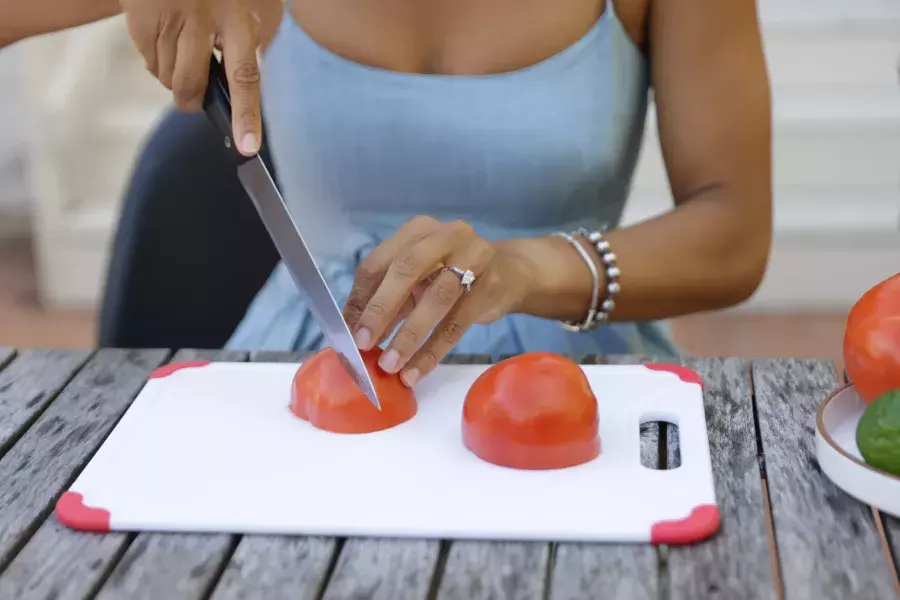
The cleanliness of cutting boards is a long-debated food safety issue, given that both wood and plastic — the most common cutting board materials — can easily harbor bacteria. New research shows that using plastic cutting boards can release microplastics. So how concerned should you be?
A 2023 study published in the journal Environmental Science & Technology found that using a plastic cutting board can create between 1,536 and 7,680 small flecks of plastic, which can get onto your knife and into your food. Microplastics are easily ingested due to their microscopic size, and research shows that they can accumulate within the human body.
Understandably, there is concern over the long-term health effects of this, especially given the fact that “microplastics are, indeed, everywhere,” Mark Jones, a retired industrial chemist and chemistry consultant with expertise in microplastics, tells Yahoo Life. In addition to cutting boards, microplastics shed from single-use water bottles, clothing, tires, paint and more, he adds.
How harmful are plastic cutting boards?
Plastic cutting boards are just one of the many ways people are exposed to microplastics. We all already have thousands of microplastic particles within us. However, there is no conclusive evidence yet about their long-term health effects in humans. “We're just starting to look into the human health impacts,” explains Tasha Stoiber, a senior scientist at the Environmental Working Group.
However, there is plenty of research to prove that microplastics are harmful to the environment and animals. Animal studies, for example, have linked microplastics to potential oxidative stress (damage at the cellular level), reproductive harm and endocrine disruption (interfering with the body’s hormones).
The question is, how concerned should humans be about using plastic cutting boards when they are, as Jones says, “but a minor part of all the microplastics that your body is inundated with on a daily basis”? To put this in perspective, authors of a recent paper published in Proceedings of the National Academy of Sciences studied three popular bottled water brands and found that a liter of water, on average, contains around 240,000 nanoplastic particles, much more plastic than that discussed in the cutting board study.
Should you throw out your plastic cutting boards?
Experts are a bit mixed on this. “I'm not throwing my plastic cutting boards away based on this, because I don't see that there is currently any hard evidence of health impacts coming from whatever plastics we are consuming,” says Jones. However, he adds, “The absence of data, right now, of any health impact does not mean there will not be a health impact in the future.”
Stoiber, who doesn’t use plastic cutting boards, errs on the side of caution: “We’re just beginning to understand the magnitude of how this much plastic might be getting into our bodies,” she says. “I don't think we have the full picture yet, but the findings are concerning.”
Aside from microplastics, there are other reasons to reconsider your cutting board’s material. “Plastics can also be a vehicle for a number of different chemicals that you don't want to be exposed to — phthalates, for example,” says Stoiber. Phthalates are a group of chemicals used to make plastics more durable, but they may be harmful. Plastic cutting boards are also more likely to harbor bacteria and are more difficult to disinfect than, say, wood ones, Stoiber explains. Their soft surface easily develops grooves from cutting, which essentially become “impossible to wash,” she adds. “That's, personally, why I would never use a plastic cutting board.”
Plastic cutting boards are also generally less durable and more disposable than other cutting boards, which makes them a pretty unsustainable pick, Stoiber adds.
What can you do about it?
“Anything that you can do to reduce your plastic exposure is a good thing,” says Stoiber. “And what you use in the kitchen is a good place to start.”
She recommends opting for a wood — a hard wood like maple or bamboo are good options — or even metal cutting board instead, both of which are more durable, and therefore, less likely to groove and harbor bacteria. Whatever you choose, just be sure to wash with dish soap and warm water after every use. (It’s also a good idea to occasionally sanitize cutting boards, such as with a diluted bleach solution — 1 gallon of water mixed with 1 tablespoon of bleach — followed by rinsing with water.)
Jones says that the ideal cutting board, though, is one that doesn't exist yet: perfectly non-porous, antibacterial and naturally sourced. “In a world that perfectly makes sense, you would use a glass cutting board with a steel knife,” he says. “The steel is not hard enough to abrade the glass cutting board, so you would never create scratches.”
If you’re worried about your ingestion of microplastics, you can ditch the plastic cutting board, but also consider your other daily — and likely more impactful — plastic uses. Rather than using disposable plastic water bottles for example, a stainless steel water bottle with filtered water, Stoiber says, is “a great way to cut down on the ingestion of microplastics.” She also recommends not using or reheating plastic storage containers or takeout containers, as heat promotes the release of more microplastics.